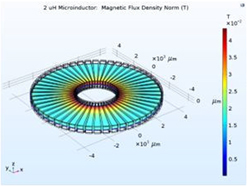Article contents
Finite element modeling of nanoscale-enabled microinductors for power electronics
Published online by Cambridge University Press: 13 August 2018
Abstract

This article focuses on the finite element modeling of toroidal microinductors, employing first-of-its-kind nanocomposite magnetic core material and superparamagnetic iron nanoparticles covalently cross-linked in an epoxy network. Energy loss mechanisms in existing inductor core materials are covered as well as discussions on how this novel core material eliminates them providing a path toward realizing these low form factor devices. Designs for both a 2 μH output and a 500 nH input microinductor are created via the model for a high-performance buck converter. Both modeled inductors have 50 wire turns, less than 1 cm3 form factors, less than 1 Ω AC resistance, and quality factors, Q’s, of 27 at 1 MHz. In addition, the output microinductor is calculated to have an average output power of 7 W and a power density of 3.9 kW/in3 by modeling with the 1st generation iron nanocomposite core material.
- Type
- Article
- Information
- Journal of Materials Research , Volume 33 , Issue 15: Focus Issue: Soft Magnetic Materials: Synthesis, Characterization, and Applications , 13 August 2018 , pp. 2223 - 2233
- Copyright
- Copyright © Materials Research Society 2018
Footnotes
This author was an editor of this journal during the review and decision stage. For the JMR policy on review and publication of manuscripts authored by editors, please refer to http://www.mrs.org/editor-manuscripts/.
References
REFERENCES
- 4
- Cited by




